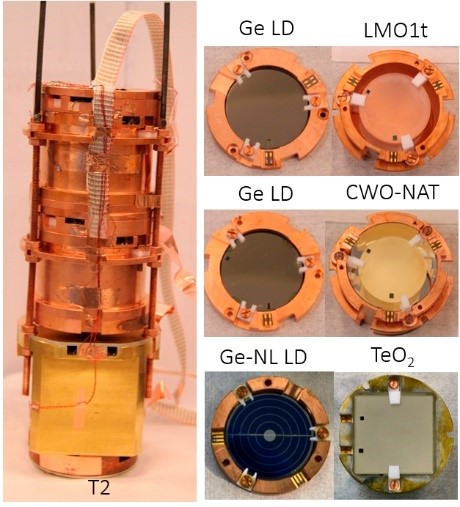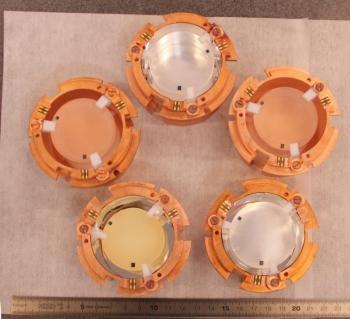Tests of the LUMINEU detectors are ongoing since 2013 in the cryogenic laboratory of CSNSM (Orsay, France), at LSM (France) and LNGS (Italy).
- We have developed a purification-crystallization protocol for the production of high quality crystals implying low irrecoverable losses (< 4%) of the costly enriched molybdenum. Crystal growth is performed at NIIC (Novosibirsk, Russia).
- We have ascertained that the crystal growth is much easier for Li2MoO4 than for ZnMoO4, providing boules with more regular shapes and less macroscopic defects and inclusions.
- Several 44 mm diameter, 170 micron thick Ge light detectors were fabricated according to a robust mounting scheme developed at CSNSM and successfully tested on different ZMO detectors. Study of the immunity to noise vibrations and the absolute light responsivity of existing light detectors (diameters 25 mm & 40 mm) developed at IAS has been performed at CSNSM in Ulysse cryostat.
- We have performed a dedicated R&D to control the internal 40K content in Li2MoO4. The present recipe, which includes the use of a selected ultapure Li2CO3 powder for the compound synthesis and a double crystallization procedure, allowed us to achieve a harmless 40K activity, inferior to 6 mBq/kg.
- Ten Ge wafers were irradiated at the Orphée reactor for the NTD sensor production specific for LUMINEU. Several NbSi film superconductive thermistors have been prepared and characterized as alternative temperature sensors.
- A Monte Carlo simulation of the background expected for the LMO detectors in the EDELWEISS cryostat is in progress, with the objective to evaluate the sensitivity of the pilot LUMINEU experiment (4 enriched crystals, 0.7 kg enriched material) and of a possible CUPID-MO experiment with 40 crystals and 6 kg enriched material.
- In 2015-2016 we performed a test of two large-volume modules (ZnMoO4 and Li2100MoO4 crystal) in LSM, France. Enriched molybdenum was provided by the LUMINEU collaborators of ITEP (Moscow, Russia) and KINR (Kyiv, Ukraine). The goal was to compare two types of detectors to choose one with better properties and performance and to check new suspension system for reduction of low frequency noise. Though ZnMoO4 is a very promising material as well, Li2MoO4 devices have superior performance and radiopurity, and a less pronounced boule-position dependence. All these characteristics allowed us to choose Li2100MoO4 compound as main part of detectors for final stage of LUMINEU experiment with 40 crystals.
- Also independent measurement of the Li2100MoO4 was performed in 2016 in LNGS, Italy, to compare radiopurity and performance of two crystals from the same boule.
- In 2016 new run with two suspended towers in LSM had started. The aim is to test performance and operation of four enriched Li2100MoO4 crystals before preparing and performing a demonstrator for CUPID with 20 crystals. Also towers contain two R&D detectors: CdWO4 and TeO2 with Neganov-Luke light detector.
- The growth of 20 enriched Li2MoO4 crystals has started in 2016 in NIIC, containing ~ 3 kg of 100Mo in total. Additional 20 crystals will be grown in 2017.


Two suspended towers, installed in LSM in 2016.


